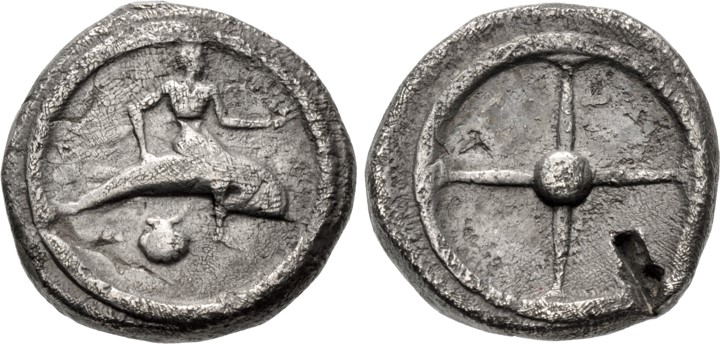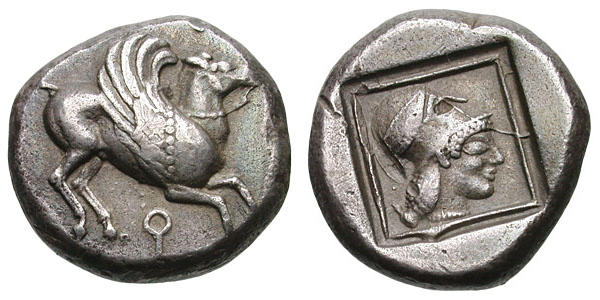21686 - Taras (nomos Taras/wheel FB 4) over Corinth (Pegasus/Athena) (CNG, EA 536, Apr. 2023, 3)
From SILVER
480 BCE - 470 BCE
Location/history
| Sale(s)Sale(s) ᵖ: | Myers, 6, 6 Dec. 1973, 12 = Classical Numismatic Group, EA 536, 12 April 2023, 3. Lot includes an old A.H. Baldwin & Sons flip and ticket. | |
Overstriking coin
Description
| ObverseInscription or printing placed on the obverse.: | Taras, nude, both arms outstretched, riding dolphin left, scallop shell below | ReverseInscription or printing placed on the reverse.: | Wheel of four spokes |
Mint and issuing power
| MintIdentifies the place of manufacture or issue of a numismatic object.: | Taras | Ancient regionAncient region. | Calabria | Modern countryModern country: Italy | AuthorityIdentifies the issuing power. The authority can be "pretended" when the name or the portrait of X is on the coin but he/she was not the issuing power. It can also be "uncertain" when there is no mention of X on the coin but he/she was the issuing power according to the historical sources: |
Chronology
| FromIdentifies the initial date in a range assigned in a numismatic context. 480 BCE toIdentifies the final date in a range assigned in a numismatic context.. 470 BCE | Classical 480-323 BC |
Physical description
| MetalThe physical material (usually metal) from which an object is made.: Silver |
WeightWeight of the numismatic object (in grams). in grams: 7.247.24 g <br />7,240 mg <br /> | DenominationTerm indicating the value of a numismatic object. Examples: tetradrachm, chalkous, denarius.: nomos | |
| DiameterDescribes diameter of an object (in mm).: 18.518.5 mm <br />1.85 cm <br /> | StandardStandard.: Achaian | ||
References
| Coin referenceReference of the Coin: | Coin series referenceReference to coin series study: | Ravel 19471Ravel 1947, n° 75 (same rev. die), Fischer-Bossert 19992Fischer-Bossert 1999, Group 4, n° 75 (V35/R55), HN Italy3HN Italy, n° 833, HGC 14HGC 1, n° 754-755 | |
| Coin series web referenceCoin series web references: | |||
Overstruck type
Description
| ObverseInscription or printing placed on the obverse.: | Pegasus flying | ReverseInscription or printing placed on the reverse.: | Head of Athena r., wearing helmet in an incuse square |
Mint and issuing power
| MintIdentifies the place of manufacture or issue of a numismatic object. ᵖ: | Corinth | Ancient regionAncient region. ᵖ | Peloponnesus | Modern countryModern country: Greece | AuthorityIdentifies the authority in whose name (explicitly or implicitly) a numismatic object was issued. ᵖ: |
Chronology
| FromIdentifies the initial date in a range assigned in a numismatic context. 510 BCE toIdentifies the final date in a range assigned in a numismatic context.. 475 BCE | Archaic until 480 BC |
Physical description
| DenominationTerm indicating the value of a numismatic object. Examples: tetradrachm, chalkous, denarius. ᵖ: | stater |
StandardStandard. ᵖ: | Aeginetic |
References
| Coin type referenceReference to coin series study ᵖ: | Ravel 19365Ravel 1936, Calciati 19906Calciati 1990 | ||
| Coin series web reference overstruckCoin series web references overstruck: | |||
Additional data
| Frequency of overstrikesFrequency of overstrikes: | rare and concentrated | Level of confidenceLevel of confidence of the identification: | strong |
| RemarksRemarks: | "overstruck on uncertain type" | ||
References
- ^ Ravel, Oscar E. (1990), Descriptive catalogue of the collection of Tarentine coins formed by M. P. Vlasto, London, Spink
- ^ Fischer-Bossert, Wolfgang (1999), Chronologie der Didrachmenprägung von Tarent, 510-280 v. Chr., Berlin, De Gruyter, xvii, 495 p., [84] pl.
- ^ Rutter N. Keith et alii (eds.) (2001), Historia Numorum Italy, London, xvi, 223 p., 43 pl.
- ^ Hoover, Oliver D. (2018), The Handbook of Greek Coinage Series, Volume 1. Handbook of Coins of Italy and Magna Graecia, Sixth to First Centuries BC., Lancaster-London, 2018, lxi, 527 pages, 23 cm
- ^ Ravel, Oscar E (1936), Les "Poulains" de Corinthe : monographie des statères corinthiens. Tome I: de 650 à 415 J.-C., Basel.
- ^ Calciati, Romolo (1990), Pegasi, Mortara, Edizioni I.P..

